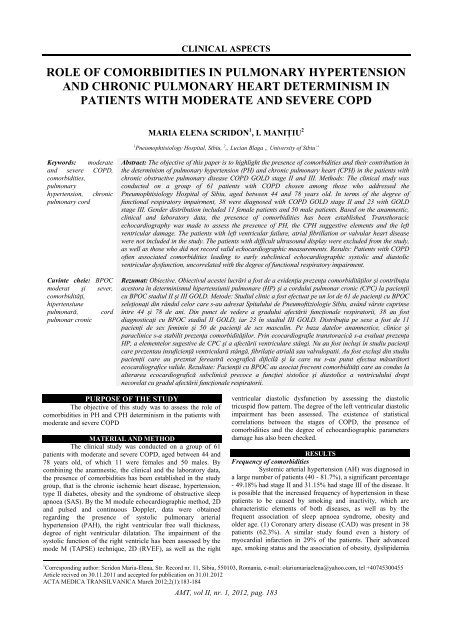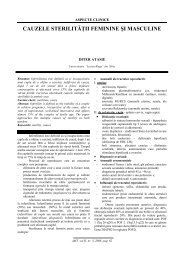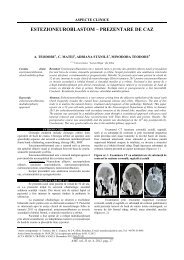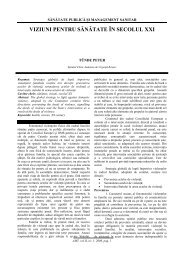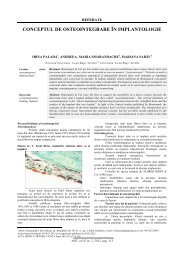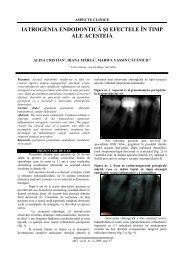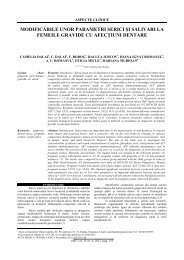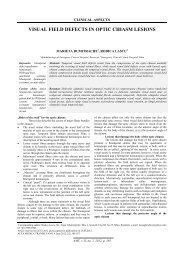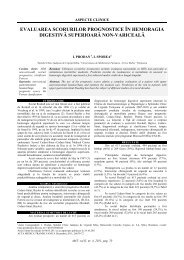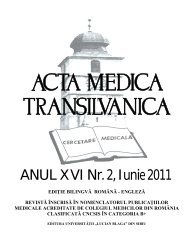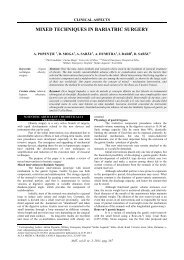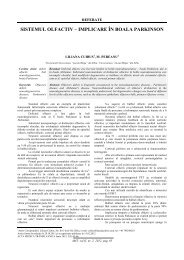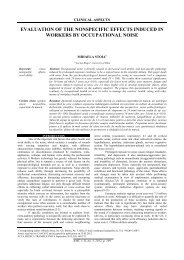role of comorbidities in pulmonary hypertension and chronic
role of comorbidities in pulmonary hypertension and chronic
role of comorbidities in pulmonary hypertension and chronic
Create successful ePaper yourself
Turn your PDF publications into a flip-book with our unique Google optimized e-Paper software.
CLINICAL ASPECTS<br />
ROLE OF COMORBIDITIES IN PULMONARY HYPERTENSION<br />
AND CHRONIC PULMONARY HEART DETERMINISM IN<br />
PATIENTS WITH MODERATE AND SEVERE COPD<br />
MARIA ELENA SCRIDON 1 , I. MANIŢIU 2<br />
1 Pneumophtisiology Hospital, Sibiu, 2 „ Lucian Blaga „ University <strong>of</strong> Sibiu”<br />
Keywords: moderate<br />
<strong>and</strong> severe COPD,<br />
<strong>comorbidities</strong>,<br />
<strong>pulmonary</strong><br />
<strong>hypertension</strong>, <strong>chronic</strong><br />
<strong>pulmonary</strong> cord<br />
Cuv<strong>in</strong>te cheie: BPOC<br />
moderat şi sever,<br />
comorbidităţi,<br />
hipertensiune<br />
pulmonară, cord<br />
pulmonar cronic<br />
Abstract: The objective <strong>of</strong> this paper is to highlight the presence <strong>of</strong> <strong>comorbidities</strong> <strong>and</strong> their contribution <strong>in</strong><br />
the determ<strong>in</strong>ism <strong>of</strong> <strong>pulmonary</strong> <strong>hypertension</strong> (PH) <strong>and</strong> <strong>chronic</strong> <strong>pulmonary</strong> heart (CPH) <strong>in</strong> the patients with<br />
<strong>chronic</strong> obstructive <strong>pulmonary</strong> disease COPD GOLD stage II <strong>and</strong> III. Methods: The cl<strong>in</strong>ical study was<br />
conducted on a group <strong>of</strong> 61 patients with COPD chosen among those who addressed the<br />
Pneumophtisiology Hospital <strong>of</strong> Sibiu, aged between 44 <strong>and</strong> 78 years old. In terms <strong>of</strong> the degree <strong>of</strong><br />
functional respiratory impairment, 38 were diagnosed with COPD GOLD stage II <strong>and</strong> 23 with GOLD<br />
stage III. Gender distribution <strong>in</strong>cluded 11 female patients <strong>and</strong> 50 male patients. Based on the anamnestic,<br />
cl<strong>in</strong>ical <strong>and</strong> laboratory data, the presence <strong>of</strong> <strong>comorbidities</strong> has been established. Transthoracic<br />
echocardiography was made to assess the presence <strong>of</strong> PH, the CPH suggestive elements <strong>and</strong> the left<br />
ventricular damage. The patients with left ventricular failure, atrial fibrillation or valvular heart disease<br />
were not <strong>in</strong>cluded <strong>in</strong> the study. The patients with difficult ultrasound display were excluded from the study,<br />
as well as those who did not record valid echocardiographic measurements. Results: Patients with COPD<br />
<strong>of</strong>ten associated <strong>comorbidities</strong> lead<strong>in</strong>g to early subcl<strong>in</strong>ical echocardiographic systolic <strong>and</strong> diastolic<br />
ventricular dysfunction, uncorrelated with the degree <strong>of</strong> functional respiratory impairment.<br />
Rezumat: Obiective. Obiectivul acestei lucrări a fost de a evidenţia prezenţa comorbidităţilor şi contribuţia<br />
acestora în determ<strong>in</strong>ismul hipertensiunii pulmonare (HP) şi a cordului pulmonar cronic (CPC) la pacienţii<br />
cu BPOC stadiul II şi III GOLD. Metode: Studiul cl<strong>in</strong>ic a fost efectuat pe un lot de 61 de pacienţi cu BPOC<br />
seleţionaţi d<strong>in</strong> rândul celor care s-au adresat Spitalului de Pneum<strong>of</strong>tiziologie Sibiu, având vârste cupr<strong>in</strong>se<br />
între 44 şi 78 de ani. D<strong>in</strong> punct de vedere a gradului afectării funcţionale respiratorii, 38 au fost<br />
diagnosticaţi cu BPOC stadiul II GOLD, iar 23 în stadiul III GOLD. Distribuţia pe sexe a fost de 11<br />
pacienţi de sex fem<strong>in</strong><strong>in</strong> şi 50 de pacienţi de sex mascul<strong>in</strong>. Pe baza datelor anamnestice, cl<strong>in</strong>ice şi<br />
paracl<strong>in</strong>ice s-a stabilit prezenţa comorbidităţilor. Pr<strong>in</strong> ecocardiografie transtoracică s-a evaluat prezenţa<br />
HP, a elementelor sugestive de CPC şi a afectării ventriculare stângi. Nu au fost <strong>in</strong>cluşi în studiu pacienţi<br />
care prezentau <strong>in</strong>suficienţă ventriculară stângă, fibrilaţie atrială sau valvulopatii. Au fost excluşi d<strong>in</strong> studiu<br />
pacienţii care au prezntat fereastră ecografică dificilă şi la care nu s-au putut efectua măsurători<br />
ecocardiografice valide. Rezultate: Pacienţii cu BPOC au asociat frecvent comorbidităţi care au condus la<br />
alterarea ecocardiografică subcl<strong>in</strong>ică precoce a funcţiei sistolice şi diastolice a ventriculului drept<br />
necorelat cu gradul afectării funcţionale respiratorii.<br />
PURPOSE OF THE STUDY<br />
The objective <strong>of</strong> this study was to assess the <strong>role</strong> <strong>of</strong><br />
<strong>comorbidities</strong> <strong>in</strong> PH <strong>and</strong> CPH determ<strong>in</strong>ism <strong>in</strong> the patients with<br />
moderate <strong>and</strong> severe COPD<br />
MATERIAL AND METHOD<br />
The cl<strong>in</strong>ical study was conducted on a group <strong>of</strong> 61<br />
patients with moderate <strong>and</strong> severe COPD, aged between 44 <strong>and</strong><br />
78 years old, <strong>of</strong> which 11 were females <strong>and</strong> 50 males. By<br />
comb<strong>in</strong><strong>in</strong>g the anamnestic, the cl<strong>in</strong>ical <strong>and</strong> the laboratory data,<br />
the presence <strong>of</strong> <strong>comorbidities</strong> has been established <strong>in</strong> the study<br />
group, that is the <strong>chronic</strong> ischemic heart disease, <strong>hypertension</strong>,<br />
type II diabetes, obesity <strong>and</strong> the syndrome <strong>of</strong> obstructive sleep<br />
apnoea (SAS). By the M module echocardiographic method, 2D<br />
<strong>and</strong> pulsed <strong>and</strong> cont<strong>in</strong>uous Doppler, data were obta<strong>in</strong>ed<br />
regard<strong>in</strong>g the presence <strong>of</strong> systolic <strong>pulmonary</strong> arterial<br />
<strong>hypertension</strong> (PAH), the right ventricular free wall thickness,<br />
degree <strong>of</strong> right ventricular dilatation. The impairment <strong>of</strong> the<br />
systolic function <strong>of</strong> the right ventricle has been assessed by the<br />
mode M (TAPSE) technique, 2D (RVEF), as well as the right<br />
ventricular diastolic dysfunction by assess<strong>in</strong>g the diastolic<br />
tricuspid flow pattern. The degree <strong>of</strong> the left ventricular diastolic<br />
impairment has been assessed. The existence <strong>of</strong> statistical<br />
correlations between the stages <strong>of</strong> COPD, the presence <strong>of</strong><br />
<strong>comorbidities</strong> <strong>and</strong> the degree <strong>of</strong> echocardiographic parameters<br />
damage has also been checked.<br />
RESULTS<br />
Frequency <strong>of</strong> <strong>comorbidities</strong><br />
Systemic arterial <strong>hypertension</strong> (AH) was diagnosed <strong>in</strong><br />
a large number <strong>of</strong> patients (40 - 81.7%), a significant percentage<br />
- 49.18% had stage II <strong>and</strong> 31.15% had stage III <strong>of</strong> the disease. It<br />
is possible that the <strong>in</strong>creased frequency <strong>of</strong> <strong>hypertension</strong> <strong>in</strong> these<br />
patients to be caused by smok<strong>in</strong>g <strong>and</strong> <strong>in</strong>activity, which are<br />
characteristic elements <strong>of</strong> both diseases, as well as by the<br />
frequent association <strong>of</strong> sleep apnoea syndrome, obesity <strong>and</strong><br />
older age. (1) Coronary artery disease (CAD) was present <strong>in</strong> 38<br />
patients (62.3%). A similar study found even a history <strong>of</strong><br />
myocardial <strong>in</strong>farction <strong>in</strong> 29% <strong>of</strong> the patients. Their advanced<br />
age, smok<strong>in</strong>g status <strong>and</strong> the association <strong>of</strong> obesity, dyslipidemia<br />
1 Correspond<strong>in</strong>g author: Scridon Maria-Elena, Str. Record nr. 11, Sibiu, 550103, Romania, e-mail: olariumariaelena@yahoo.com, tel +40745300455<br />
Article recived on 30.11.2011 <strong>and</strong> accepted for publication on 31.01.2012<br />
ACTA MEDICA TRANSILVANICA March 2012;2(1):183-184<br />
AMT, vol II, nr. 1, 2012, pag. 183
<strong>and</strong> <strong>hypertension</strong> has an important <strong>role</strong> <strong>in</strong> their appearance. (1,2)<br />
There has not been demonstrated any significant association<br />
between the COPD stage <strong>and</strong> the presence <strong>of</strong> ischemic coronary<br />
disease (χ2 test, p = 0.422, α = 0.05). A large number <strong>of</strong> patients<br />
recorded high body mass <strong>in</strong>dex, respectively 24.59%<br />
overweight, 29.5% obesity 1, 8.2% obesity 2 <strong>and</strong> 6.56% obesity<br />
3, fact noted <strong>and</strong> <strong>in</strong> other studies, too. (2) Diabetes mellitus type<br />
II was also frequently found <strong>in</strong> the patients <strong>of</strong> our study group<br />
(15 to 24.59%). There was no statistical significant correlation<br />
between COPD stages <strong>and</strong> the presence <strong>of</strong> diabetes mellitus.<br />
SAS was diagnosed <strong>in</strong> 36 <strong>of</strong> the 61 patients with COPD. Of the<br />
36 patients with overlap-syndrome, 7 were diagnosed with mild<br />
SAS (IAH 12.37/h), 4 with moderate SAS (AHI 24.5/h), 25 with<br />
severe SAS, IAH (48.6/h). We found a significant association<br />
between COPD stage <strong>and</strong> the severity <strong>of</strong> sleep apnea, measured<br />
by apnea hypopnea <strong>in</strong>dex (AHI) (χ2 test, p = 0.048, α = 0.05).<br />
SAS was a risk factor for lower TAPSE


